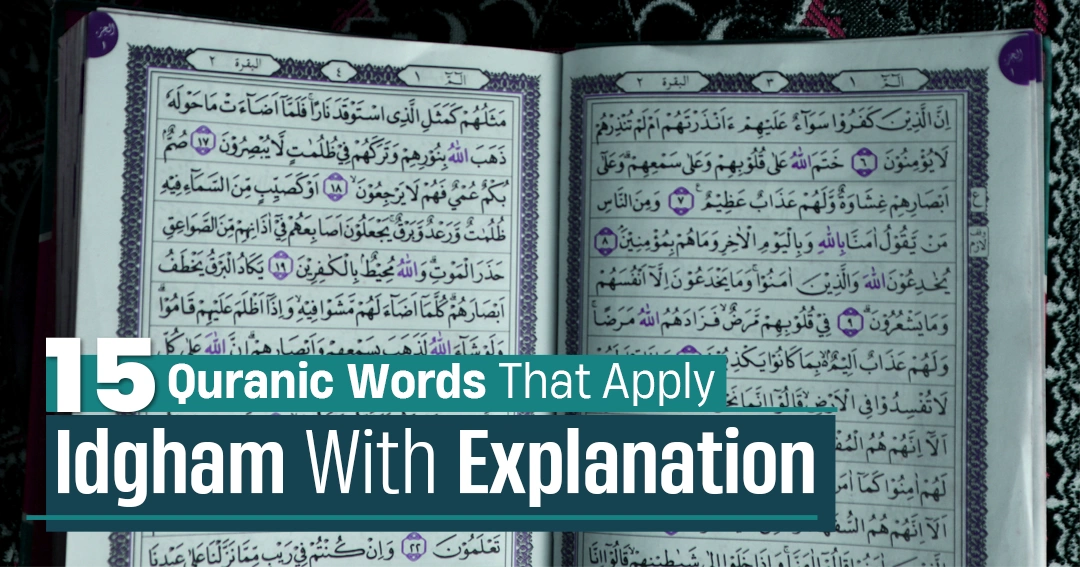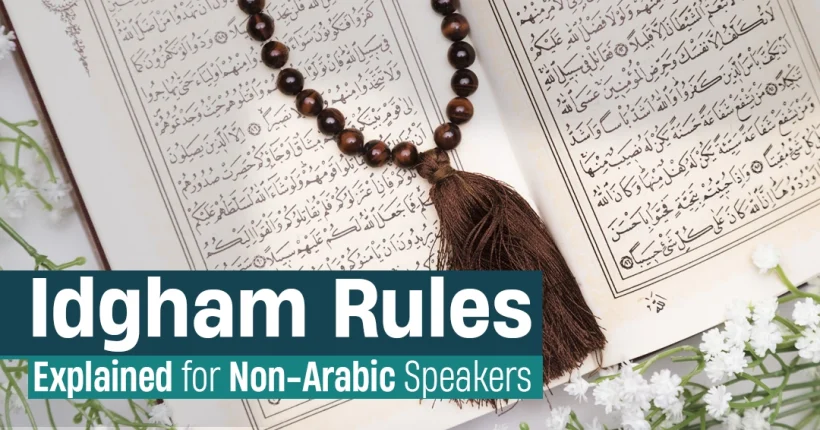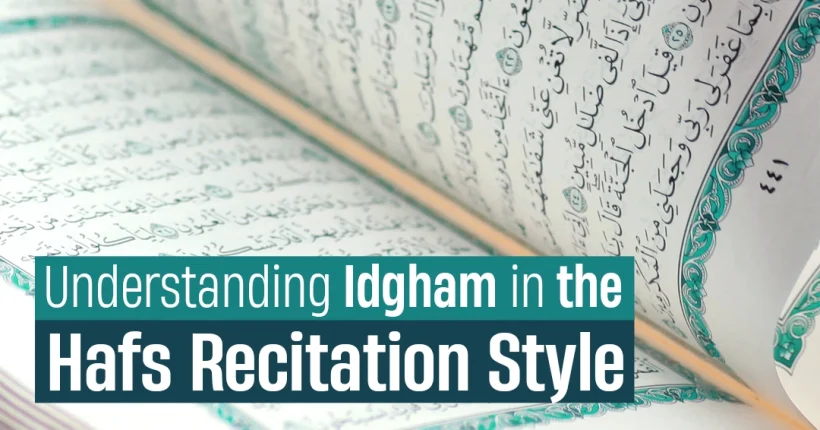Words in Quran with Idgham are the key to helping you master the rule of Idgham. In this article, we will explore some of the Idgham examples from the Quran, the types of Idgham, and more. Let’s get started!
What is Idgham in Tajweed?
Idgham means “merging,” and it refers to blending one letter into another during recitation without breaking the flow. This rule plays a big role in how certain Words in Quran with Idgham are beautifully and correctly pronounced, bringing rhythm and fluency to your reading.
How Idgham Works in Quranic Recitation
In Tajweed, Idgham occurs when a Noon Saakin (نْ) or Tanween (ً ٍ ٌ) is followed by specific letters from the Arabic alphabet. Instead of pronouncing both letters separately, you merge them smoothly.
This merging can be done with Ghunnah (a nasal sound) or without Ghunnah, depending on the following letter. Mastering this helps learners recite Words in Quran with Idgham Idgham more naturally and melodiously.
The Six Letters That Trigger Idgham
There are six letters that cause Idgham when they follow Noon Saakin or Tanween:
ي، ر، م، ل، و، ن (Ya, Ra, Meem, Lam, Waw, Noon).
These are split into two categories:
- Idgham with Ghunnah (nasal sound): ي، ن، م، و
- Idgham without Ghunnah: ل، ر
For example, when you come across Words in Quran with Idgham like “مِنْ رَبِّهِمْ” (min rabbihim), the Noon merges into the Ra without a nasal sound — a perfect case of Idgham without Ghunnah.
15 Common Words in Quran with Idgham
To help you identify and apply Idgham confidently, we’ve compiled a list of 15 frequently recited Words in Quran with Idgham. Each example includes a breakdown of the rule, the type of Idgham, and tips to perfect your pronunciation. Whether you’re a beginner or brushing up your Tajweed skills, this list is a practical starting point.

Want guided help? Tareequl Jannah Academy offers expert-led sessions to help you master Idgham and other Tajweed rules directly from the Quran.
1. مِنۡ رَّبِّهِمۡ
- Transliteration: min rabbihim
- Translation: from their Lord
- Ayah Reference: Surah Al-Baqarah (2:5)
- Type of Idgham: Without Ghunnah
- Explanation: Noon Saakin (نْ) is followed by the letter ر (Ra), which triggers Idgham without nasalization.
- Pronunciation Tip: Don’t pause between min and rabbihim — merge the Noon sound smoothly into the Ra without a nasal tone.
2. مَن يَقُولُ
- Transliteration of one of the Words in Quran with Idgham: man yaqoolu
- Translation: whoever says
- Ayah Reference: Surah Al-Baqarah (2:118)
- Type of Idgham: With Ghunnah
- Explanation: Noon Saakin is followed by ي (Ya), causing Idgham with Ghunnah (nasal sound).
- Pronunciation Tip: Hold the nasal sound for a beat before continuing to yaqoolu.
3. غَفُورٌ رَّحِيمٌ
- Transliteration: ghafoorun raheem
- Translation: Most Forgiving, Most Merciful
- Ayah Reference: Surah Al-Baqarah (2:173)
- Type of Idgham: Without Ghunnah
- Explanation: Tanween (ٌ) on ghafoorun is followed by ر (Ra).
- Pronunciation Tip: Eliminate the “n” sound in Tanween and flow directly into raheem.
4. سَمِيعٌۢ بَصِيرٌ
- Transliteration of one of the Words in Quran with Idgham: samee’un baseer
- Translation: All-Hearing, All-Seeing
- Ayah Reference: Surah An-Nisa (4:58)
- Type of Idgham: With Ghunnah
- Explanation: Tanween (ٌ) followed by ب (Ba), which actually falls under Iqlab, but often confused with Idgham. Included here for contrast and clarity.
- Pronunciation Tip: Use nasal sound through the nose and pronounce baseer with light “m” hum.
5. خَيْرٌۭ وَأَبْقَىٰ
- Transliteration: khayrun wa-abqaa
- Translation of the Words in Quran with Idgham: better and more lasting
- Ayah Reference: Surah Al-A’la (87:17)
- Type of Idgham: With Ghunnah
- Explanation: Tanween (ٌ) followed by و (Waw) = Idgham with Ghunnah.
- Pronunciation Tip: Merge the “n” sound into the “w” with a soft nasal tone.
6. كَانَ نُورًا
- Transliteration: kaana nooran
- Translation: was a light
- Ayah Reference: Surah At-Tahrim (66:8)
- Type of Idgham: With Ghunnah
- Explanation: Word ends in ن (Noon), followed by another ن (Noon) — triggers Idgham with Ghunnah.
- Pronunciation Tip: Hold the nasal sound clearly before transitioning to nooran.
7. مِّن لَّدُنۡ
- Transliteration: min ladun
- Translation of the Words in Quran with Idgham: from near (Him)
- Ayah Reference: Surah Al-Kahf (18:65)
- Type of Idgham: Without Ghunnah
- Explanation: Noon Saakin followed by ل (Lam) = Idgham without nasalization.
- Pronunciation Tip: Join min and ladun without a nasal hum.
8. إِن يَشَأِ
- Transliteration: in yashaa’
- Translation of the Words in Quran with Idgham: if He wills
- Ayah Reference: Surah Al-An’am (6:46)
- Type of Idgham: With Ghunnah
- Explanation: Noon Saakin followed by ي (Ya).
- Pronunciation Tip: Use a gentle nasal tone to merge into yashaa’ smoothly.
9. يَوْمَئِذٍۢ نَّاعِمَةٌ
- Transliteration: yawma’idhin na‘imah
- Translation: that Day will be joyful
- Ayah Reference: Surah Al-Ghashiyah (88:8)
- Type of Idgham: With Ghunnah
- Explanation: Tanween (ٍ) followed by ن (Noon) = Idgham with Ghunnah.
- Pronunciation Tip: Blend the “n” from Tanween into na‘imah with a prolonged nasal sound.
10. فَمَن مَّاتَ
- Transliteration of the Words in Quran with Idgham: faman maata
- Translation: so whoever dies
- Ayah Reference: Surah Al-Baqarah (2:178)
- Type of Idgham: With Ghunnah
- Explanation: Noon Saakin followed by م (Meem) = Idgham with Ghunnah.
- Pronunciation Tip: Let the nasal sound echo slightly before continuing to maata.
11. شَيْءٌۭ مِّنۡهُم
- Transliteration: shay’un minhum
- Translation: anything of them
- Ayah Reference: Surah Al-A’raf (7:188)
- Type of Idgham: With Ghunnah
- Explanation: Tanween (ٌ) followed by م (Meem) = Idgham with Ghunnah.
- Pronunciation Tip: Pause slightly in the nasal area before proceeding to minhum.
12. خَيْرٌۭ نَّافِعًا
- Transliteration of the Words in Quran with Idgham: khayrun naafi‘an
- Translation: better and beneficial
- Ayah Reference: Implied structure, occurs in similar constructs
- Type of Idgham: With Ghunnah
- Explanation: Tanween followed by ن (Noon) triggers nasal merging.
- Pronunciation Tip: Enunciate the “na” sound with clear nasal echo.
13. مِّنۡ وَلِيٍّ
- Transliteration: min waliyyin
- Translation: from any protector
- Ayah Reference: Surah At-Tawbah (9:116)
- Type of Idgham: With Ghunnah
- Explanation: Noon Saakin followed by و (Waw).
- Pronunciation Tip: Focus on a light nasal tone before articulating waliyyin.
14. عَلِيمٌۭ حَكِيمٌ
- Transliteration: ‘aleemun hakeem
- Translation of the Words in Quran with Idgham: All-Knowing, All-Wise
- Ayah Reference: Surah Al-Baqarah (2:32)
- Note: This is a non-Idgham Tanween followed by Ha, included to show contrast.
- Explanation: No Idgham here — Ha is not one of the Idgham letters.
- Pronunciation Tip: Don’t merge; pronounce Tanween clearly before continuing.
15. كَانَ لَهُۥ نُورًا
- Transliteration: kaana lahu nooran
- Translation: had for him a light
- Ayah Reference: Surah At-Tahrim (66:8)
- Type of Idgham: With Ghunnah (from second Noon)
- Explanation: The phrase structure highlights lahu nooran with Idgham involving Noon.
- Pronunciation Tip: Let the “n” sound blend naturally into the next Noon with nasalization.
Ready to Recite with Confidence? Join Tareequl Jannah Academy to receive personalized Tajweed coaching, practical examples, and correction to help you apply Words in Quran with Idgham the right way — every time.
Types of Idgham and Their Signs

Before diving deeper into more Words in Quran with Idgham, let’s pause for a quick and clear review. Understanding the types of Idgham will help you recognize and apply this rule correctly every time you recite.
1. Idgham with Ghunnah (Nasal Sound)
This type of Idgham involves a nasal sound that lasts for two counts. It occurs when a Noon Saakin or Tanween is followed by one of these four letters:
- ي (Ya), ن (Noon), م (Meem), و (Waw).
Signs to look for in the Mushaf for Words in Quran with Idgham:
- A small Meem or Noon-like symbol on the letter that follows.
- No sukoon sign on the Noon or Tanween.
- Listen for a nasal humming sound when you say the word.
Example of a word in Quran with Idgham with Ghunnah:
- مَن يَقُولُ (man yaqoolu)
Here, the Noon (ن) merges into the Ya (ي) with a nasal sound.
2. Idgham without Ghunnah (No Nasal Sound)
This type of Idgham is smooth and silent — without any nasalization. It occurs when Noon Saakin or Tanween is followed by:
- ل (Lam) or ر (Ra).
Signs to look for in the Mushaf:
- No indication of ghunnah.
- Smooth connection between the merged sounds.
- Clear, quick blending — no nasal hum.
Example of a Words in Quran with Idgham without Ghunnah:
- مِن رَّبِّهِمْ (min rabbihim)
Here, the Noon (ن) is merged into the Ra (ر) without any nasal tone.
Tip for Identifying Idgham Types:
- Ghunnah = nasal sound (Ya, Noon, Meem, Waw)
- No Ghunnah = no nasal sound (Lam, Ra)
Practice makes recognition natural — over time, you’ll spot these instantly in your Mushaf.
Practice Tips for Learners

Now that you’ve explored common Words in Quran with Idgham, it’s time to put your knowledge into practice. Tajweed mastery doesn’t happen overnight — it’s a journey of repetition, listening, and refinement.
These practical tips will help you develop fluency and confidence when reciting words with Idgham:
1. Listen to Expert Reciters Daily
- Hearing the correct application of Idgham is just as important as reading it.
- Start with slow-paced reciters like Sheikh Al-Husary or Mishary Alafasy.
- Focus especially on Surahs with clear Idgham examples (like Al-Baqarah or Al-Kahf).
- Replay ayahs containing Idgham until your ear picks up the merging and nasal sounds naturally.
2. Highlight Idgham Words in Your Mushaf
Use a color-coded highlighter or sticky notes to mark the Words in Quran with Idgham:
- Noon Saakin and Tanween instances.
- The six Idgham letters: ي، ر، م، ل، و، ن.
- This visual method makes it easier to pause and apply the rule correctly while reciting.
3. Practice Aloud — Slowly and Clearly
- Reading silently won’t help you detect errors in Idgham.
- Recite aloud and focus on smooth merging (Idgham) or clear nasal sound (if required).
- Record yourself and compare with expert recitations.
- Use simple examples like من ربهم or من ولي to start.
4. Ask for Feedback from a Tajweed Teacher
- Even if you’re practicing on your own with Words in Quran with Idgham, feedback is key.
- Join a Tajweed class or get a one-on-one session with a qualified teacher.
- Tareequl Jannah Academy offer structured guidance and correction.
- A teacher will correct subtle mistakes you might not catch on your own.
5. Set a “Word of the Day” Goal
- Don’t try to memorize all the rules at once.
- Pick one word in Quran with Idgham each day.
- Recite it in different contexts and write it in a practice notebook.
- Reflect on what kind of Idgham it has (with or without Ghunnah).
6. Use Flashcards or Tajweed Apps
Make digital or physical flashcards with:
- The Words in Quran with Idgham
- The type of Idgham
- A short audio or video example
- This method makes Tajweed revision fun, quick, and portable.
7. Don’t Rush — Let the Rules Settle
- You won’t master Idgham in a day — and that’s okay.
- Repetition and slow, thoughtful recitation build long-term accuracy.
- If you’re unsure, go back and review examples from earlier sections.
- Always prioritize understanding over speed.
Want to Learn with Support?
At Tareequl Jannah Academy, you’ll get hands-on Tajweed training with real Quranic examples, including how to apply the rules in words in Quran with Idgham — taught by certified instructors in a supportive, step-by-step approach.
Deepen Your Understanding of Idgham Rule:
Discover the various types of idgham in tajweed and how they apply to Quranic recitation.
Explore real-life idgham letters with examples from Quran to solidify your grasp of Idgham letters.
Explore how idgham in Hafs recitation is applied.
Break down language barriers with simplified explanations of idgham rules for non-native speakers.
Learn about the best online tajweed class idgham focus designed to help you master Idgham.





